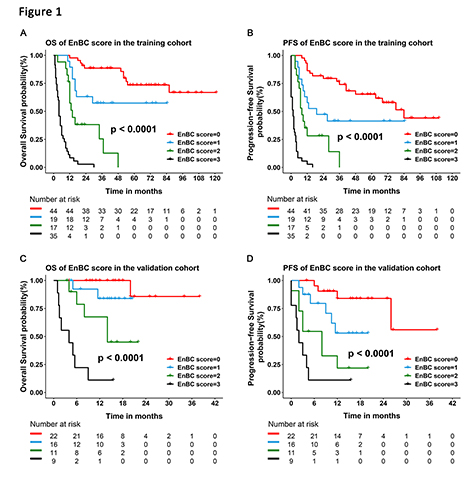
Contributions
Abstract: EP562
Type: E-Poster Presentation
Session title: Aggressive Non-Hodgkin lymphoma - Clinical
Background
The current prognostic scoring systems for mature T and NK cell lymphomas have been found limitations in predicting survival outcomes. Novel predictors and precise risk stratification systems are lacking. Abnormal lipid metabolism was reported to influence the initiation and progression of malignancies. Nevertheless, the significance of dyslipidemia in mature T and natural killer (NK) cell lymphomas remains unexplored.
Aims
To investigate the association between serum lipid metabolism level and clinical outcomes, and further develop a lipid-covered prognostic model for newly-diagnosed mature T and NK cell lymphoma patients.
Methods
A total of 173 patients (1/2006-6/2020) were enrolled in this study, of which 115 constituted the training cohort while 58 composed the prospective validation cohort. The basic data comparison of the two cohorts was performed by Student t test or Mann-Whitney U test for continuous variables and the chi-square test or Fisher’s exact test for categorical data. Univariate analysis and multivariate Cox regression analysis were performed to detect independent predictors and generate a novel prognostic model, whose performance was further assessed in the training and validation cohort from multiple aspects, including Harrell’s C-index, calibration curves, Kaplan-Meier survival analysis, time-dependent receiver operating characteristic curves, Brier score and decision curve analysis.
Results
Univariate analysis verified declined cholesterol (TC), high-density lipoprotein cholesterol (HDL-C) and increased triglycerides (TG) were associated with inferior survival outcomes in mature T and NK lymphomas. Multivariate analysis revealed extranodal involved sites≥2 (HR: 2.505; P=0.031), β2-MG≥3mg/L (HR: 3.964; P=0.005) and TC<3.58mmol/L (HR: 3.320; P=0.000) were three independent predictors. Thus, a novel prognostic model, EnBC score, was constituted with these three variables. EnBC score possessed satisfactory discrimination and calibration since the Harrell’s C-index for OS prediction was 0.840 (95% CI, 0.810-0.870) and the calibration curves showed an optimal agreement between the prediction and actual observation. The prognostic significance of the novel model was verified in Kaplan-Meier survival analysis by dividing patients into four risk groups with different long-term survival (median OS, NA vs. NA vs. 14.0 vs. 4.0 months, P<0.0001; median PFS, 84.0 vs. 19.0 vs. 8.0 vs. 1.5 months, P<0.0001) (Figure 1). Compared with the present International Prognostic Index (IPI), EnBC score presented better discrimination (time-dependent AUCs of OS, EnBC 0.883-0.963 vs. IPI 0.785-0.873, P<0.001) and better calibration (Brier score of OS, EnBC 0.146-0.271 vs. IPI 0.154-0.296, P=0.023). Moreover, the decision curve analysis showed that EnBC score provided larger net benefits than IPI in the entire patient population.

Conclusion
Serum lipid metabolism level was firstly demonstrated significantly prognosis-related in mature T and NK cell lymphomas. Furthermore, a novel lipid-covered prognostic scoring system was established and performed well in predicting the prognoses of treat-naïve mature T and NK cell lymphoma patients.
Keyword(s): Lipid metabolism, Prognosis, T cell lymphoma
Abstract: EP562
Type: E-Poster Presentation
Session title: Aggressive Non-Hodgkin lymphoma - Clinical
Background
The current prognostic scoring systems for mature T and NK cell lymphomas have been found limitations in predicting survival outcomes. Novel predictors and precise risk stratification systems are lacking. Abnormal lipid metabolism was reported to influence the initiation and progression of malignancies. Nevertheless, the significance of dyslipidemia in mature T and natural killer (NK) cell lymphomas remains unexplored.
Aims
To investigate the association between serum lipid metabolism level and clinical outcomes, and further develop a lipid-covered prognostic model for newly-diagnosed mature T and NK cell lymphoma patients.
Methods
A total of 173 patients (1/2006-6/2020) were enrolled in this study, of which 115 constituted the training cohort while 58 composed the prospective validation cohort. The basic data comparison of the two cohorts was performed by Student t test or Mann-Whitney U test for continuous variables and the chi-square test or Fisher’s exact test for categorical data. Univariate analysis and multivariate Cox regression analysis were performed to detect independent predictors and generate a novel prognostic model, whose performance was further assessed in the training and validation cohort from multiple aspects, including Harrell’s C-index, calibration curves, Kaplan-Meier survival analysis, time-dependent receiver operating characteristic curves, Brier score and decision curve analysis.
Results
Univariate analysis verified declined cholesterol (TC), high-density lipoprotein cholesterol (HDL-C) and increased triglycerides (TG) were associated with inferior survival outcomes in mature T and NK lymphomas. Multivariate analysis revealed extranodal involved sites≥2 (HR: 2.505; P=0.031), β2-MG≥3mg/L (HR: 3.964; P=0.005) and TC<3.58mmol/L (HR: 3.320; P=0.000) were three independent predictors. Thus, a novel prognostic model, EnBC score, was constituted with these three variables. EnBC score possessed satisfactory discrimination and calibration since the Harrell’s C-index for OS prediction was 0.840 (95% CI, 0.810-0.870) and the calibration curves showed an optimal agreement between the prediction and actual observation. The prognostic significance of the novel model was verified in Kaplan-Meier survival analysis by dividing patients into four risk groups with different long-term survival (median OS, NA vs. NA vs. 14.0 vs. 4.0 months, P<0.0001; median PFS, 84.0 vs. 19.0 vs. 8.0 vs. 1.5 months, P<0.0001) (Figure 1). Compared with the present International Prognostic Index (IPI), EnBC score presented better discrimination (time-dependent AUCs of OS, EnBC 0.883-0.963 vs. IPI 0.785-0.873, P<0.001) and better calibration (Brier score of OS, EnBC 0.146-0.271 vs. IPI 0.154-0.296, P=0.023). Moreover, the decision curve analysis showed that EnBC score provided larger net benefits than IPI in the entire patient population.

Conclusion
Serum lipid metabolism level was firstly demonstrated significantly prognosis-related in mature T and NK cell lymphomas. Furthermore, a novel lipid-covered prognostic scoring system was established and performed well in predicting the prognoses of treat-naïve mature T and NK cell lymphoma patients.
Keyword(s): Lipid metabolism, Prognosis, T cell lymphoma


